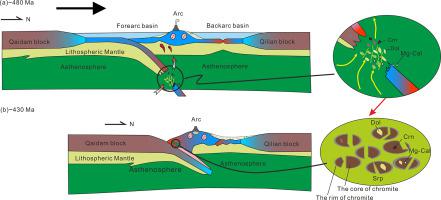当前位置:
X-MOL 学术
›
Gondwana Res.
›
论文详情
Our official English website, www.x-mol.net, welcomes your feedback! (Note: you will need to create a separate account there.)
Two stages of crust-mantle interaction during oceanic subduction to continental collision: Insights from mafic-ultramafic complexes in the North Qaidam orogen
Gondwana Research ( IF 7.2 ) Pub Date : 2021-01-01 , DOI: 10.1016/j.gr.2020.08.018 Pengjie Cai , Xin Chen , Jarosław Majka , Iwona Klonowska , Pauline Jeanneret , Rongke Xu , Youye Zheng
Gondwana Research ( IF 7.2 ) Pub Date : 2021-01-01 , DOI: 10.1016/j.gr.2020.08.018 Pengjie Cai , Xin Chen , Jarosław Majka , Iwona Klonowska , Pauline Jeanneret , Rongke Xu , Youye Zheng

|
Abstract Subducted sedimentary rocks contribute to different reservoirs in the mantle, which results in crust-mantle interaction; however, the metasomatic processes involved in this sedimentary contribution to the mantle still remain poorly understood. Chromite is a robust mineral and together with its inclusions, occurring in orogenic peridotite, it is an important candidate for decoding both the petrogenetic and tectonic settings as well as crust-mantle interaction. This study presents an integrated petrological and geochemical study of the chromitite-bearing Luofengpo mafic-ultramafic complex (CLMC) in the North Qaidam orogen, China. The CLMC consists of amphibole pyroxenite, serpentinized peridotite, and serpentinized pyroxenite. Electron probe micro-analysis and laser ablation inductively coupled plasma mass spectrometry analysis demonstrated that the studied chromite grains display compositional zoning with the cores preserving primary igneous compositions. Chromitites with high Cr#(100*Cr/(Cr+Al)) signatures are enriched in IPGE (Os, Ir, and Ru) and depleted in PPGE (Rh, Pt, and Pd) indicating that they formed in the supra-subduction zone mantle wedge. Core compositions of chromite grains indicate that the parental melts of the chromitites were similar to typical boninitic melts, formed in a forearc setting related to subduction initiation. Petrographic, geochronological, and mineralogical analyses suggest that the CLMC underwent at least two stages of crust-mantle interaction. The first stage (metasomatic agent) occurred at 483.1 ± 3.5 Ma. The metasomatic agent was a hydrous melt derived from a mixed source of carbonates and sediments, subducted with the south Qilian oceanic slab. The second stage (metasomatic fluids) occurred at 434.2 ± 2.1 Ma and the metasomatic fluids originated from subduction and exhumation of the deeply subducted continental crust. These results suggest that the CLMC represents a supra-subduction zone mantle wedge slice, metasomatized by at least two stages of subduction crustal fluids during the transition from oceanic subduction to continental collision in the North Qaidam ultrahigh pressure metamorphic belt.
更新日期:2021-01-01














































 京公网安备 11010802027423号
京公网安备 11010802027423号